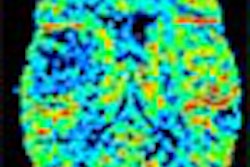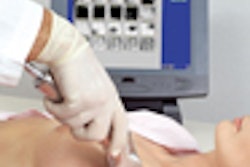SAN FRANCISCO - Ultrasound is a new but promising method of localizing the prostate gland and positioning patients for prostate cancer treatment.
At the American Society for Therapeutic Radiology and Oncology (ASTRO) conference on Tuesday, radiation oncologist Dr. Christopher Serago discussed his team's work at the Mayo Clinic to assess the suitability of ultrasound for positioning patients for external beam radiation therapy.
"In the radiation oncology community, there's not a lot of historical experience using ultrasound for this process," he said. "That was true for us as well."
Using a BAT (B-mode acquisition and targeting) ultrasound-based targeting system (Nomos, Sewickley, PA), Serago and colleagues from Mayo Clinic sites in Jacksonville, FL, and Scottsdale, AZ, assessed the ultrasound positioning process by asking several questions:
- How does the magnitude of ultrasound-based positions compare to the alignment of patients using conventional skin markings?
- How reproducible is ultrasound imaging?
- Can individual anatomic characteristics be used to predict the success or failure of the process?
- Does the pressure of the ultrasound probe affect the prostate position?
- What QA measures can help ensure the accuracy of the process?
In all, the researchers evaluated 38 patients undergoing radiation therapy treatment for prostate cancer. Each patient was aligned with skin marks first, and then ultrasound images were acquired. The patient was then repositioned, and the difference between the skin mark position and the ultrasound position was recorded.
"On a single day for a single patient, we find that about 7% of the time we had to shift the patient in either a longitudinal or vertical direction more than 10 mm -- and not quite as frequently were lateral shifts needed [avg.: 0.7 mm]."
Reproducibility was assessed in two ways: first by measuring 15 of the patients twice during the same day, with a single ultrasound operator who repeated the same examinations twice in rapid succession. To test interoperator variability among all 38 patients, two ultrasound operators performed ultrasound positioning in rapid succession, and the final patient positions were compared by calculating the cumulative probability of the move as a function of the distance moved.
When the same operators performed the same exam twice, they reached the same position (within 1 mm) 80%-90% of the time, Serago said. However, results were not quite as good when two operators working independently positioned the same patient.
"In this case, the two operators reached the same position (within 1 mm) 50%-80% of the time," he said. Yet the measurements fell within 4 mm of each other 95% of the time.
To identify poor predictors of ultrasound image quality, 22 of the patients were evaluated with pre-treatment CT scans.
"From those patients, the statistically significant indicators were depth to the prostate, thickness of tissue anterior to the bladder," and the spatial orientation of the prostate relative to the skeletal structure, i.e., the position of the gland relative to the pubic symphysis, Serago said.
"Interestingly, bladder volume was not statistically significant as a predictive indicator," he said. (This was not a comparison of full vs. empty bladder, he said; patients were instructed to keep the bladder as full as possible).
Finally, the effect of the ultrasound probe was assessed by taking two CT scans on the same day, both with a mock ultrasound probe and without it. The probe pressure displaced the prostate by an average of 3.1 mm in 45% of patients; the remaining patients were unaffected. An audience member asked how much pressure was applied. Serago said the pressure varies with each exam in the clinical setting, so no attempt was made to quantify the pressure of the mock probe.
A manufacturer-supplied phantom was used every day during the study to check the alignment of lasers, the readout position of the articulated arm, and the overall operation of the ultrasound unit. The vendor-supplied QA program was very useful in correcting several calibration problems that occurred in a single instance, he said.
"In conclusion, this ultrasound system does provide reproducible results, within about 3-4 mm," Serago said. "In our experience, ultrasound localization doesn't indicate the need for significant moves. [Repositioning is needed] only about 7% of the time."
By Eric BarnesAuntMinnie.com staff writer
November 7, 2001
Copyright © 2001 AuntMinnie.com



















